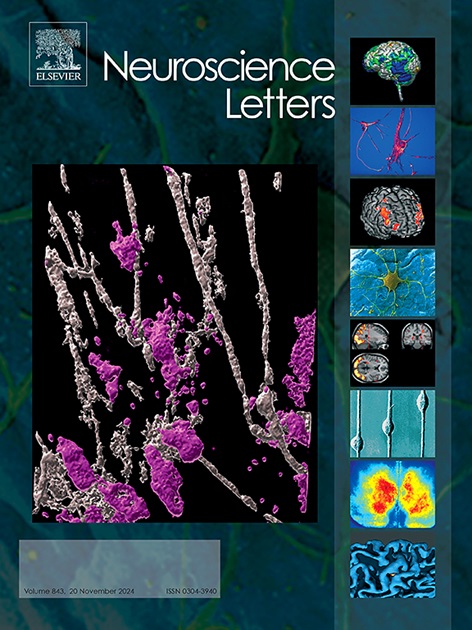Increasing indoxyl sulfate induces iNOS expression via aryl hydrocarbon receptor leading to microglia hyperactivation in the prefrontal cortex of autism-like offspring rats
IF 2
4区 医学
Q3 NEUROSCIENCES
引用次数: 0
Abstract
The abnormal indole metabolism is associated with the progression of Autism Spectrum Disorder (ASD). Indoxyl sulfate (IS), one of the active products of indole metabolism, still has an unknown role in ASD progression. This study investigates the role of IS/Aryl hydrocarbon receptor (AhR)/iNOS pathway in microglial activation in the prefrontal cortex (PFC) of ASD-like rats. Prenatal LPS-exposed induced autism-like behaviors offspring rats, concomitant with increased IS levels in the PFC. The levels of nuclear-AhR, IBA1, CD16 and iNOS proteins expression were increased in the PFC of LPS-exposed rats, whereas ARG1 protein expression level decreased, indicates microglia hyperactivation coupled with altered microglia morphology. ELISA analysis and further measure of synapses changes showed significantly increased inflammatory factors (TNF-α and IL-1β) and synaptic alterations. In vitro experiments demonstrated that IS treatment significantly upregulated the expression level of nuclear-AhR, enhanced microglia marker (IBA1, CD16 and iNOS) proteins and pro-inflammation factors levels (TNF-α and IL-1β), while concurrently reducing ARG1 protein expression and IL-10 levels in BV2 microglial cells. Moreover, the IS treatment significantly enhanced AhR enrichment in iNOS promoter region by chromatin immunoprecipitation and dual luciferase reporter assays, thereby significantly elevating the iNOS expression. However, the AhR-specific antagonist CH-223191 could block this activation and reverse the above proteins and inflammation factors changes. In a word, increased IS levels in the PFC of ASD-like offspring rats activate the AhR/iNOS pathway, driving microglial hyperresponsiveness and contributing to the development of ASD disease.
增加硫酸吲哚酚通过芳烃受体诱导iNOS表达,导致自闭症样子代大鼠前额皮质小胶质细胞过度活化。
吲哚代谢异常与自闭症谱系障碍(ASD)的发展有关。吲哚代谢的活性产物之一硫酸吲哚酯(Indoxyl sulfate, IS)在ASD进展中的作用尚不清楚。本研究探讨IS/芳香烃受体(AhR)/iNOS通路在asd样大鼠前额皮质(PFC)小胶质细胞活化中的作用。妊娠lps暴露诱导子代大鼠出现自闭症样行为,同时PFC中IS水平升高。lps暴露大鼠PFC中核- ahr、IBA1、CD16和iNOS蛋白表达水平升高,而ARG1蛋白表达水平降低,提示小胶质细胞过度活化并改变小胶质细胞形态。ELISA分析和进一步测量突触变化显示炎症因子(TNF-α和IL-1β)显著增加和突触改变。体外实验表明,IS处理显著上调BV2小胶质细胞核ahr表达水平,增强小胶质细胞标志物(IBA1、CD16和iNOS)蛋白和促炎症因子(TNF-α和IL-1β)水平,同时降低ARG1蛋白表达和IL-10水平。此外,通过染色质免疫沉淀和双荧光素酶基因报告基因检测,IS处理显著增强了iNOS启动子区域AhR的富集,从而显著提高了iNOS的表达。然而,ahr特异性拮抗剂CH-223191可以阻断这种激活,逆转上述蛋白和炎症因子的变化。综上所述,ASD样子代大鼠PFC中IS水平升高激活AhR/iNOS通路,驱动小胶质细胞高反应性,促进ASD疾病的发展。
本文章由计算机程序翻译,如有差异,请以英文原文为准。
求助全文
约1分钟内获得全文
求助全文
来源期刊

Neuroscience Letters
医学-神经科学
CiteScore
5.20
自引率
0.00%
发文量
408
审稿时长
50 days
期刊介绍:
Neuroscience Letters is devoted to the rapid publication of short, high-quality papers of interest to the broad community of neuroscientists. Only papers which will make a significant addition to the literature in the field will be published. Papers in all areas of neuroscience - molecular, cellular, developmental, systems, behavioral and cognitive, as well as computational - will be considered for publication. Submission of laboratory investigations that shed light on disease mechanisms is encouraged. Special Issues, edited by Guest Editors to cover new and rapidly-moving areas, will include invited mini-reviews. Occasional mini-reviews in especially timely areas will be considered for publication, without invitation, outside of Special Issues; these un-solicited mini-reviews can be submitted without invitation but must be of very high quality. Clinical studies will also be published if they provide new information about organization or actions of the nervous system, or provide new insights into the neurobiology of disease. NSL does not publish case reports.
 求助内容:
求助内容: 应助结果提醒方式:
应助结果提醒方式:


